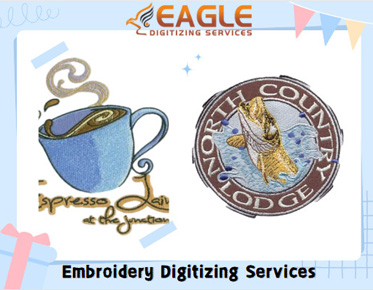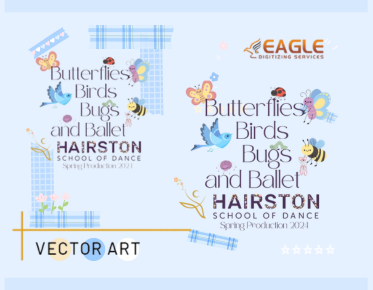Tips for Choosing Embroidery Fabrics and Threads for Different Design Requirements
Embroidery is an art form that thrives on the synergy between fabric and thread. Choosing the right combination can elevate your creations to new heights of elegance and sophistication. In this guide, we'll delve into the intricacies of selecting embroidery fabrics and threads to suit a myriad of design requirements.
Understanding
Different Fabric Types
Embroidery enthusiasts must acquaint themselves with the diverse array of fabrics available. From the timeless allure of natural fibers to the innovative possibilities of synthetics, each material offers unique characteristics that influence the outcome of your embroidery masterpiece.
Natural Fabrics
- Cotton: Known for its
breathability and versatility, cotton is a popular choice among
embroiderers. Its smooth texture provides an ideal canvas for intricate
stitch work, making it suitable for a wide range of projects.
- Linen: Renowned for its
strength and durability, linen exudes a rustic charm that adds character
to embroidered designs. Its slightly coarse texture lends a tactile
quality to finished pieces, perfect for achieving a vintage or artisanal
aesthetic.
- Silk: Embodied with luxury and elegance, silk is the epitome of sophistication in embroidery. Its lustrous sheen and delicate drape make it ideal for capturing intricate details and achieving a refined, high-end finish.
Synthetic Fabrics
- Polyester: Offering
durability and resistance to wrinkles, polyester is a practical choice for
everyday embroidery projects. Its smooth surface allows for crisp, defined
stitches, making it suitable for both intricate designs and bold, graphic
motifs.
- Rayon: With its silky
texture and vibrant sheen, rayon adds a touch of glamour to embroidered
creations. It drapes beautifully and glides effortlessly through fabric,
making it well-suited for embellishing garments and accessories with
intricate patterns and decorative accents.
- Nylon: Recognized for its strength and resilience, nylon is a versatile synthetic fiber that lends itself well to embroidery on challenging surfaces such as leather or vinyl. Its smooth, glossy finish enhances the visibility of stitches, making it an excellent choice for decorative topstitching and appliqué work.
Factors
to Consider When Choosing Fabric
Embroidery success hinges on selecting the right fabric to complement your design. Several factors come into play, including texture, density, color, and stretch, each influencing the overall look and feel of the finished piece.
Texture: The tactile quality of the fabric can enhance or detract from the visual impact of embroidery. Smooth fabrics like silk or cotton satin showcase intricate stitch work, while textured fabrics like linen or tweed add dimension and depth to designs.
Density: The density of the fabric affects how well it can support embroidery stitches. Lightweight fabrics may require stabilizers to prevent puckering, while heavyweight fabrics offer stability for dense or intricate designs.
Color: The color of the fabric sets the stage for the embroidery design, influencing its overall visual impact. Consider contrast for bold, eye-catching effects, or opt for tone-on-tone embroidery for a subtle, sophisticated look.
Stretch: Stretchy fabrics like knits or spandex require special consideration when embroidering to prevent distortion or puckering. Stabilizers or specialty needles may be necessary to ensure smooth stitching on stretch fabrics.
Selecting
Embroidery Threads
The choice of embroidery thread is equally crucial, as it can enhance or detract from the beauty of your design. Understanding the different types, weights, and colors of threads allows embroiderers to unleash their creativity with confidence.
Types of Embroidery Threads
- Cotton Thread: Prized for
its durability and matte finish, cotton thread is a staple in traditional
embroidery. It lends a classic look to designs and is suitable for a wide
range of projects, from heirloom stitching to everyday embellishments.
- Rayon Thread: Renowned for
its vibrant colors and silky texture, rayon thread adds a luxurious touch
to embroidery. It glides smoothly through the fabric, creating rich,
lustrous stitches that catch the light and dazzle the eye.
- Metallic Thread: For added sparkle and shine, metallic thread is a favorite among embroiderers seeking to elevate their designs. Available in a variety of finishes, from subtle shimmer to bold metallic hues, it adds glamour and dimension to any project.
Weight
and Thickness
The weight and thickness of the thread determine the visibility and texture of embroidery stitches. Fine threads create delicate, intricate details, while thicker threads add depth and dimension to designs. Experimenting with different weights allows for endless creative possibilities.
Color
Matching
Choosing the right thread color is essential for achieving harmony between fabric and design. Match thread colors to fabric hues for a seamless blend or opt for contrasting colors to make embroidery motifs pop. Paying attention to color theory and contrast ensures visually striking results.
Matching
Fabrics and Threads to Design Requirements
Tailoring fabric and thread choices to specific design requirements is essential for achieving desired outcomes. Whether aiming for fine details, bold motifs, or delicate embellishments, selecting the right materials sets the stage for embroidery success.
Fine
Details and Intricate Designs
For intricate designs with fine details, opt for lightweight fabrics like silk or cotton lawn paired with fine threads for crisp, precise stitching. Avoid bulky fabrics that may obscure delicate details and choose thread colors that complement the fabric for a cohesive look.
Bold
and Vibrant Designs
Bold, vibrant designs call for fabrics with a smooth surface and rich color saturation, such as cotton sateen or polyester blends. Pair with high-sheen threads in complementary or contrasting colors to create dynamic, eye-catching embroidery that commands attention.
Delicate
and Lightweight Fabrics
When embroidering delicate or lightweight fabrics like chiffon or organza, choose fine, lightweight threads that won't weigh down the fabric or cause puckering. Use stabilizers to provide support and prevent distortion, and opt for subtle, understated designs that enhance the fabric's ethereal beauty.
Heavyweight
and Sturdy Fabrics
For heavyweight or sturdy fabrics like denim or canvas, select robust threads that can withstand the rigors of dense stitching. Choose colors and finishes that coordinate with the fabric's texture and opt for bold, graphic motifs that make a statement against the fabric's substantial backdrop.
Tips for
Testing Fabrics and Threads
Before embarking on a project, it's essential to test fabrics and threads to ensure compatibility and durability. Incorporating sample stitching, washing and care tests, and durability assessments into your process can help avoid costly mistakes and ensure the longevity of your embroidery creations.
Sample
Stitching
Create test swatches using different fabrics and threads to evaluate how they interact and to experiment with stitching techniques. Assess stitch quality, tension, and coverage to determine the optimal combination for your project.
Washing
and Care Instructions
Test fabric and thread samples for colorfastness and shrinkage by washing them according to recommended care instructions. Note any changes in appearance or texture and adjust your choices accordingly to ensure long-lasting results.
Durability
Testing
Subject fabric and thread samples to wear and tear tests to gauge their durability and resilience. Consider factors such as abrasion resistance, pilling, and fading, especially for items likely to undergo frequent use or laundering.
Considering
Budget Constraints
Embroidery enthusiasts often face budget constraints when selecting materials for their projects. Balancing cost-effectiveness with quality ensures that every stitch counts, delivering exceptional results without breaking the bank.
Cost-Effective
Options
Explore budget-friendly alternatives without compromising on quality or performance. Look for discounted fabrics and threads in bulk or consider repurposing materials from thrifted or upcycled sources to stretch your budget further.
Quality
Over Quantity
Invest in high-quality fabrics and threads that offer superior performance and longevity, even if it means spending a little more upfront. Quality materials not only yield better results but also enhance the overall value and longevity of your embroidered creations.
Seeking
Professional Advice
When in doubt, don't hesitate to seek guidance from embroidery experts who can offer valuable insights and recommendations based on their experience and expertise.
Consulting
with Experts
Reach out to local embroidery shops, artisans, or online communities for advice and assistance in selecting the right materials for your project. Experienced embroiderers can provide personalized recommendations tailored to your specific needs and preferences.
Online
Resources and Forums
Explore online resources, forums, and tutorials for inspiration and guidance on fabric and thread selection. Engage with fellow embroiderers, ask questions, and share experiences to expand your knowledge and refine your skills.
Exploring
Specialized Techniques
Embroidery encompasses a wide range of techniques and styles, each requiring unique materials and expertise. Exploring specialized techniques opens up new avenues for creativity and expression in your embroidery projects.
Appliqué
Embroidery
Combine fabric and thread to create intricate appliqué designs that add depth and texture to embroidered motifs. Experiment with different fabrics and stitches to achieve stunning layered effects and dynamic compositions.
Cross-Stitch
Embroidery
Master the art of cross-stitch embroidery using aida cloth and cotton floss to create charming, pixelated designs with a nostalgic appeal. Play with color and pattern to create personalized cross-stitch masterpieces that showcase your creativity and skill.
Embossed
Embroidery
Elevate your embroidery with embossed techniques that add tactile interest and dimension to designs. Experiment with raised stitches, padded elements, and textured fabrics to create stunning three-dimensional effects that captivate the senses.
Sustainability
and Ethical Considerations
In an increasingly eco-conscious world, embroiderers are turning to sustainable and ethically sourced materials to minimize their environmental impact and support fair labor practices.
Eco-Friendly
Fabric Choices
Opt for eco-friendly fabrics made from organic or recycled materials to reduce resource consumption and minimize waste. Look for certifications such as GOTS (Global Organic Textile Standard) or OEKO-TEX® to ensure environmentally responsible sourcing and production practices.
Fair
Trade Threads
Support fair trade initiatives by choosing threads produced under ethical working conditions and fair wages. Look for certifications such as Fair Trade Certified™ or Fair Wear Foundation to ensure that your embroidery supplies uphold principles of social responsibility and economic justice.
Staying
Updated with Trends
Embroidery trends are constantly evolving, influenced by cultural shifts, technological advancements, and emerging design aesthetics. Staying informed allows embroiderers to stay ahead of the curve and infuse their work with contemporary flair.
Emerging
Fabric and Thread Innovations
Keep abreast of new developments in fabric and thread technology, from sustainable materials to innovative finishes and textures. Experiment with cutting-edge materials and techniques to push the boundaries of traditional embroidery and create modern, avant-garde designs.
Cultural
Influences
Draw inspiration from diverse cultural traditions and artistic movements to infuse your embroidery with depth and meaning. Explore global embroidery styles, motifs, and symbolism to create pieces that resonate with audiences on a universal level.
Conclusion
The art of embroidery relies on the careful selection
of fabrics and threads to bring creative visions to life. By understanding the
characteristics of different materials and considering their suitability for
specific design requirements, embroiderers can achieve stunning results that
stand the test of time. Whether creating delicate heirloom pieces or bold
contemporary designs, the right combination of fabrics and threads is essential
for success. With these tips in mind, embroiderers can embark on their projects
with confidence, knowing that their choices will result in beautiful and
enduring works of art.



